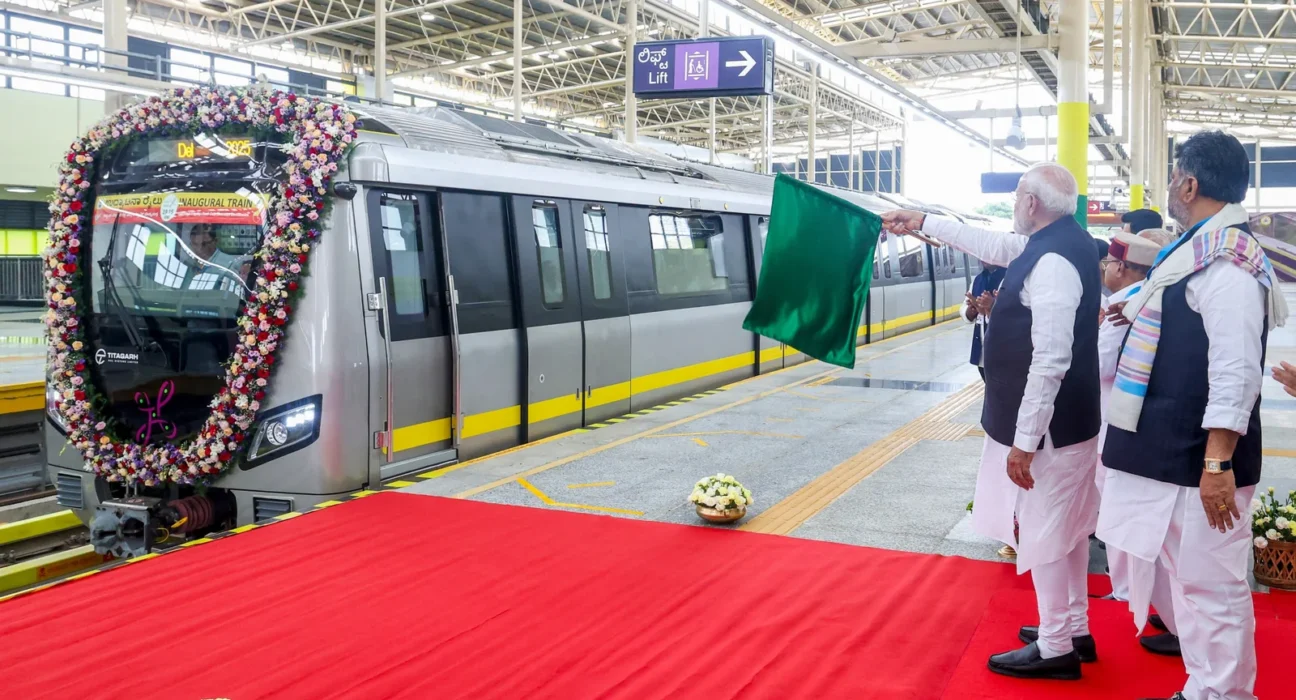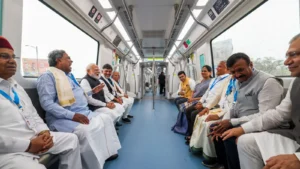Bengaluru Metro Yellow Line Opens to Public: A New Era in City Commuting!

Bengaluru’s long-awaited Yellow Line of the Namma Metro has finally opened to passengers today, marking a significant milestone in the city’s mass transit journey. This elevated corridor, connecting Rashtreeya Vidyalaya Road (RV Road) in the south to Bommasandra in the southeastern industrial belt, promises to transform how thousands of commuters travel daily. With its strategic route, interchanges, and modern infrastructure, the Yellow Line is poised to ease traffic congestion, reduce travel time, and offer a reliable alternative to road transport.
Project Background
The Yellow Line is part of Phase 2 of Namma Metro, conceived to expand the metro network into key industrial and residential areas. Construction began nearly eight years ago and faced multiple delays due to funding challenges, rolling stock procurement, and safety clearance requirements. With a project cost of approximately ₹7,610 crore, the Yellow Line represents one of the largest investments in Bengaluru’s public transport sector in recent years.
Route & Connectivity
Spanning about 19.1 kilometres, the Yellow Line is entirely elevated and features 16 stations. Starting from RV Road, it moves through densely populated residential zones, commercial hubs, and finally into Electronic City and the industrial clusters around Bommasandra.
Key stations along the route include:
-
RV Road – Interchange with the Green Line, connecting commuters to the city’s north–south corridor.
-
Jayadeva Hospital – A future interchange with the under-construction Pink Line.
-
Central Silk Board – Planned interchange with the upcoming Blue Line, linking to the airport corridor.
-
Infosys Foundation Konappana Agrahara – Funded by Infosys Foundation, serving Electronic City Phase 1.
-
Delta Electronics Bommasandra – Terminal station connecting to industrial areas and Heelalige railway station.
This alignment directly addresses one of Bengaluru’s most notorious traffic bottlenecks: Hosur Road and the Silk Board junction.
Timings & Frequency
Passenger services began today, with trains operating from 5:00 am to 11:00 pm. On weekdays, the first train departs around 6:30 am, while on Sundays, services start slightly later.
At launch, the train frequency is every 25 minutes, primarily due to the limited number of trainsets currently available. The Bengaluru Metro Rail Corporation Limited (BMRCL) plans to increase this frequency to every 10–15 minutes in the coming months as more trains are commissioned.
Fare Structure
The fare system on the Yellow Line is integrated with the rest of the Namma Metro network. Passengers can expect one-way ticket prices ranging from ₹10 to ₹90, depending on the distance travelled. Smartcard users will continue to enjoy discounted rates, and QR code ticketing is available for easy digital transactions.
Ridership Potential
Initial projections suggest the Yellow Line will serve 25,000 to 30,000 passengers daily in its early days. As operational efficiency improves and awareness grows, ridership is expected to exceed 2.5 lakh daily passengers by March 2026. Overall, the corridor is estimated to benefit up to 8 lakh people in Bengaluru, directly or indirectly.
Economic & Social Impact
The Yellow Line is expected to have a profound socio-economic impact:
-
Reduced Congestion: By offering a fast and predictable alternative to buses and private vehicles, it will help decongest key arterial roads.
-
Time Savings: Travel time between RV Road and Bommasandra is expected to reduce from over 90 minutes during peak hours to about 35–40 minutes.
-
Boost to Industrial Zones: The corridor improves accessibility to major industrial areas, potentially boosting employment and economic activity.
-
Environmental Benefits: A shift from road to metro will reduce fuel consumption and carbon emissions, contributing to the city’s sustainability goals.
Infrastructure Highlights
-
Jayadeva Hospital Station: This is Bengaluru’s first multi-elevated interchange station, featuring complex engineering to accommodate multiple metro lines at different levels.
-
Infosys Foundation Konappana Agrahara Station: Built with funding from Infosys Foundation, this station is equipped with platform screen doors, enhancing passenger safety.
-
Accessibility Features: All stations have elevators, escalators, tactile flooring, and dedicated facilities for persons with disabilities.
-
Last-Mile Connectivity: BMTC feeder buses, e-bike rentals, and EV charging stations are integrated to ensure smooth last-mile travel.

Inauguration Ceremony
The Yellow Line was inaugurated on August 10, 2025, by Prime Minister Narendra Modi, in the presence of Karnataka Chief Minister Siddaramaiah, Deputy CM D.K. Shivakumar, and other dignitaries. The inaugural ride was flagged off from RV Road, with thousands of citizens and officials attending the event. The ceremony also marked the foundation laying of Phase 3 of Namma Metro, which will add 45 km to the network at an estimated cost of ₹15,611 crore.
Challenges Faced
The journey to today’s opening was far from smooth:
-
Delays in Train Procurement: Delivery of the required trainsets took longer than expected.
-
Safety Clearances: The line underwent rigorous safety trials before the Commissioner of Metro Rail Safety (CMRS) granted approval.
-
Construction Disruptions: Land acquisition issues, shifting of utilities, and the pandemic all contributed to project delays.
Public Response
Public sentiment is overwhelmingly positive. Office-goers in Electronic City, residents in BTM Layout, and industrial workers in Bommasandra have expressed relief at the new travel option. Social media is filled with first-day photos and videos of commuters experiencing the route, praising the smooth rides and station infrastructure.
Future Outlook
With the Yellow Line now operational, Bengaluru’s metro network stretches to over 96 km, making it the second largest in India after Delhi Metro. Upcoming priorities for BMRCL include:
-
Increasing the frequency of Yellow Line trains.
-
Completing interchange facilities with the Pink and Blue Lines.
-
Expanding the network further under Phase 3 and future phases.
As the network grows, Bengaluru is gradually moving towards a fully integrated urban mobility system that could rival the best in Asia.
Conclusion
The opening of the Yellow Line marks more than just the addition of 19 kilometres of track; it represents a step change in Bengaluru’s urban mobility. For daily commuters battling traffic jams on Hosur Road, the metro now offers a dependable, fast, and sustainable alternative. While challenges remain in scaling up frequency and ensuring seamless interchanges, today’s milestone is a testament to the city’s commitment to modern, efficient public transportation. As more citizens shift from road to rail, the economic, environmental, and social benefits will only grow, shaping a better-connected and less congested Bengaluru for years to come.











